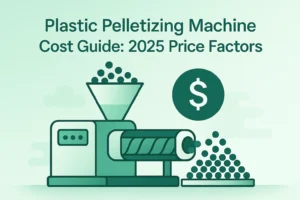Plastic film recycling faces a persistent challenge: moisture retention. After washing, plastic films typically retain 30-40% moisture content, creating bottlenecks that reduce extruder efficiency and compromise pellet quality. Plastic film squeezer technology addresses this issue directly by reducing moisture to 3% or less, transforming wet film flakes into dense, dry material ready for pelletizing.
Understanding the Moisture Problem in Film Recycling
Washed plastic films—including polyethylene (PE), polypropylene (PP), and agricultural films—present unique drying challenges due to their lightweight structure and high surface area. Traditional thermal drying methods struggle with these materials, often leaving 15-20% residual moisture even after extended drying cycles.
High moisture content creates multiple operational problems. Wet material clogs extruder feed hoppers, causing inconsistent throughput. Water trapped in melted plastic forms bubbles and weak spots in finished pellets. Extended drying times increase energy consumption and reduce overall line capacity.
According to industry data, recycling operations processing wet films without proper dewatering equipment experience 20-30% lower extruder output compared to operations using mechanical dewatering systems.[1]
How Plastic Film Squeezers Work
The squeezer employs a screw press mechanism that combines mechanical compression with controlled heating. Washed film enters the machine through a feed conveyor and moves into a compression chamber where a specially designed screw applies progressive pressure.
The screw configuration uses a unique helical geometry that prevents material wrapping while maintaining consistent compression force. As material advances through the chamber, the decreasing pitch of the screw flights increases pressure gradually, forcing water through drainage screens while compacting the plastic.
Controlled heating assists the dewatering process by slightly softening the plastic surface, allowing trapped moisture in folds and creases to escape more easily. The system maintains temperatures below the plastic’s melting point to avoid premature melting that would reduce compression efficiency.
Material exits the squeezer in a dense, granule-like form with moisture content reduced to 1-3%, making it suitable for direct feeding into pelletizing extruders.[2]
Performance Advantages for Recycling Operations
Moisture Reduction
Squeezer technology reduces moisture from 30-40% (post-washing) to 3% or less in a single pass. This moisture removal eliminates 85-90% of thermal drying requirements, significantly reducing energy consumption in downstream processing.
Research shows that properly squeezed material feeds consistently into extruders, increasing throughput capacity by 15-25% compared to operations using only centrifugal drying.[3]
Energy Efficiency
Mechanical squeezing consumes substantially less energy than thermal drying to achieve similar moisture reduction. A typical squeezer operates at 15-30 kW power consumption for 500 kg/hour throughput, compared to 60-100 kW for thermal dryers achieving comparable results.
Volume Reduction
Beyond moisture removal, squeezing compacts material by 3-4 times, reducing storage space requirements and improving material handling efficiency. Denser material flows more reliably through pneumatic conveyors and feeds more consistently into extruder hoppers.
Improved Pellet Quality
Lower moisture content in feed material produces pellets with fewer voids, more consistent density, and better mechanical properties. Operations report fewer customer complaints and reduced rejection rates after implementing squeezer technology in their processing lines.
Material Compatibility
Plastic film squeezers handle a wide range of materials commonly processed in recycling operations:
PE films: Shopping bags, stretch wrap, agricultural mulch, and greenhouse films process effectively through squeezer systems. Both LDPE and HDPE materials achieve moisture levels below 3%.
PP materials: Woven bags, raffia, jumbo bags, and PP films respond well to squeezer technology. The higher stiffness of PP compared to PE requires slightly higher compression forces but achieves similar final moisture levels.
Mixed materials: Operations processing diverse post-consumer film streams benefit from the squeezer’s ability to handle varying material types without adjustment. Material thickness ranging from 20 to 200 microns processes successfully.
Integration with Washing and Pelletizing Lines
Squeezers install between washing lines and pelletizing extruders, forming a critical bridge in the recycling process. Material flows directly from centrifugal dryers or vibrating screens into the squeezer feed hopper, maintaining continuous processing.
The squeezer’s output connects directly to extruder feed systems through pneumatic conveyors or screw feeders. Dense, low-moisture material from the squeezer flows reliably through these transfer systems without bridging or blocking that wet material commonly causes.
Automated controls synchronize squeezer operation with upstream washing equipment and downstream extruders, maintaining consistent material flow throughout the entire line. Variable frequency drives adjust screw speed based on feed rate and moisture content, optimizing performance across different material types and conditions.
Operational Considerations
Throughput capacity: Squeezers are available in capacities ranging from 300 to 1,000+ kg/hour, matching various line sizes. Proper sizing requires matching squeezer capacity to washing line output and extruder feed rate.
Maintenance requirements: Regular maintenance includes daily inspection of drainage screens, weekly lubrication of drive components, and periodic replacement of wear surfaces on screws and barrels. Well-maintained equipment operates reliably for 5-8 years before major component replacement.
Floor space: Compact design allows installation in limited spaces. Typical footprint ranges from 2-3 meters length by 1-1.5 meters width, making retrofit installation feasible in existing facilities.
Material preparation: Best results occur when material enters the squeezer with consistent size distribution. Film shredded to 50-100mm flake size processes more effectively than larger pieces.
Comparing Squeezing with Alternative Drying Methods
Centrifugal drying: Centrifuges remove surface water effectively but leave 10-15% moisture in film materials. Combining centrifugal pre-drying with squeezing provides optimal moisture reduction while minimizing energy use.
Thermal drying: Hot air dryers require substantially more energy and longer residence times than squeezing. Thermal drying alone proves less effective for lightweight films that tend to float in airstreams rather than tumbling for complete drying.
Hybrid systems: Operations processing diverse materials often implement both centrifugal and squeezing systems. Centrifuges handle initial bulk water removal, while squeezers provide final moisture reduction and material densification.
Real-World Applications
Agricultural film recyclers processing greenhouse covers and mulch films rely on squeezers to handle contaminated, heavily washed material. The mechanical action removes trapped water that centrifugal systems cannot extract from folded, clingy films.
Post-consumer film recyclers processing mixed PE waste use squeezers to standardize material moisture content despite varying incoming material conditions. Consistent moisture levels in extruder feed improve pellet quality and reduce process variability.
PP woven bag recyclers benefit particularly from squeezing technology. The open structure of woven materials traps water between fibers that mechanical pressing effectively removes, enabling direct feeding to extruders without supplemental thermal drying.
Equipment Selection Criteria
When evaluating squeezer equipment for your operation, consider these factors:
Screw design: Look for helical screw configurations with gradual pitch reduction that prevents material wrapping. Self-cleaning screw geometry reduces downtime for maintenance.
Construction materials: Hardened steel screws and wear-resistant barrel liners extend service life when processing abrasive materials. Stainless steel drainage screens resist corrosion from wash water residue.
Drive system: Direct-drive gear reducers provide superior torque capacity and reliability compared to chain or belt drives. Oversized drive systems handle startup loads and material variations without overload.
Control systems: Variable frequency drives enable speed adjustment for different materials. Automated controls that respond to moisture sensors optimize performance without operator intervention.
Discharge system: Reliable discharge mechanisms prevent material backup that reduces compression efficiency. Rotary valve or screw discharge systems maintain consistent material flow to downstream equipment.
Equipment Specifications
Explore detailed specifications and configurations for plastic film squeezing machines designed for various recycling applications. Professional systems handle capacities from 300 to 1,000+ kg/hour with moisture reduction to 3% or less.
Frequently Asked Questions
Can one machine handle both PE and PP films?
Squeezers process both PE and PP materials without equipment changes. PP materials require slightly higher compression forces due to their higher stiffness, but modern squeezers adjust automatically through variable drive controls.
What maintenance does the equipment require?
Daily maintenance includes inspecting and cleaning drainage screens. Weekly tasks involve lubricating bearings and checking drive components. Quarterly maintenance includes deep cleaning and inspecting wear surfaces. Properly maintained equipment operates reliably for multiple years.
How do I size equipment for my operation?
Match squeezer capacity to your washing line output and extruder feed requirements. Account for material density changes during squeezing—wet film expands in the feed hopper but exits as dense granules. Consult with equipment suppliers for material testing based on your specific films.



